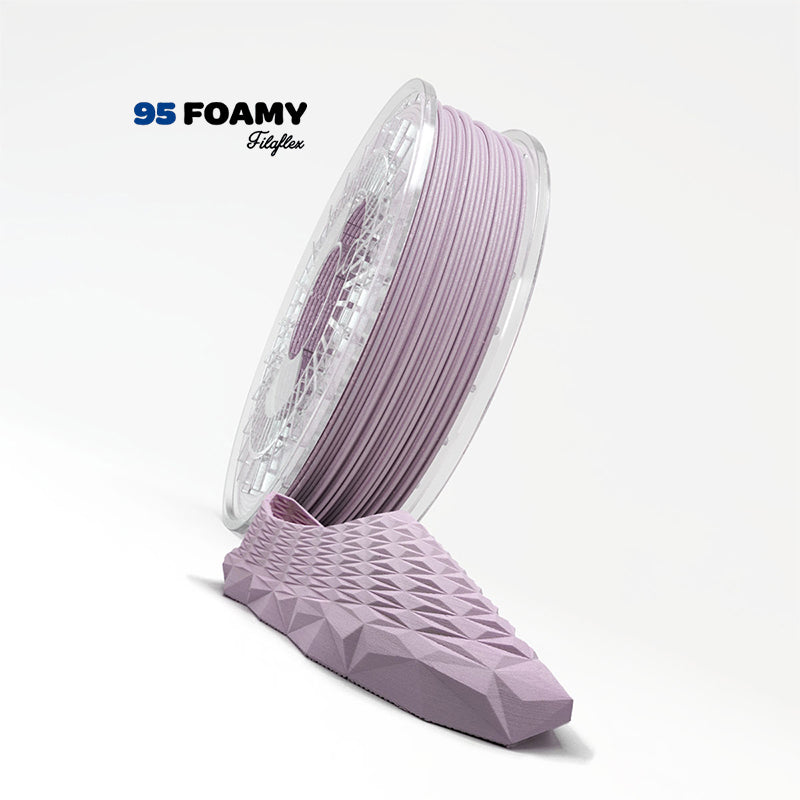
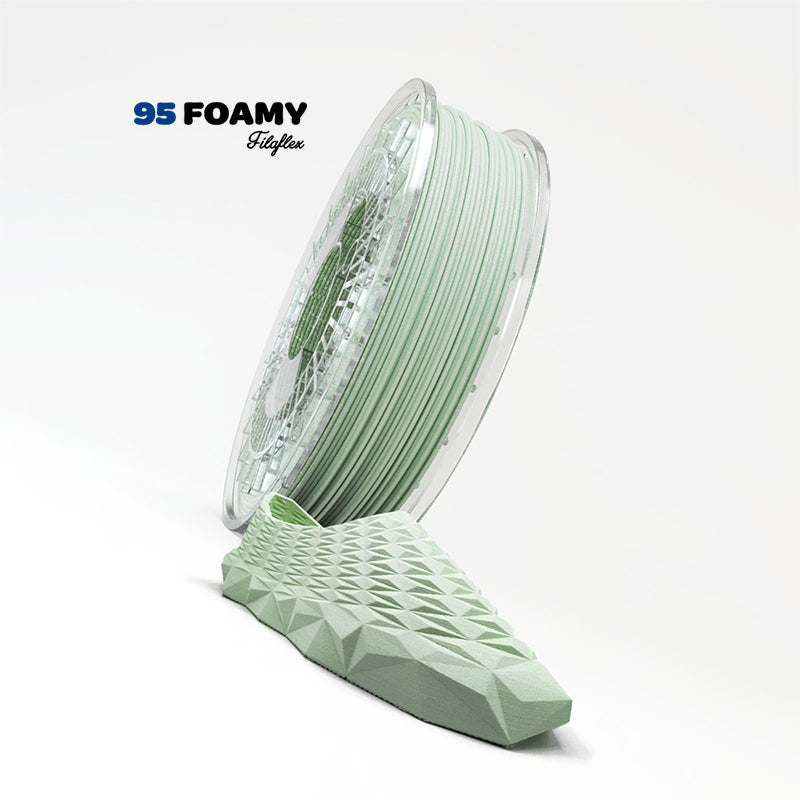
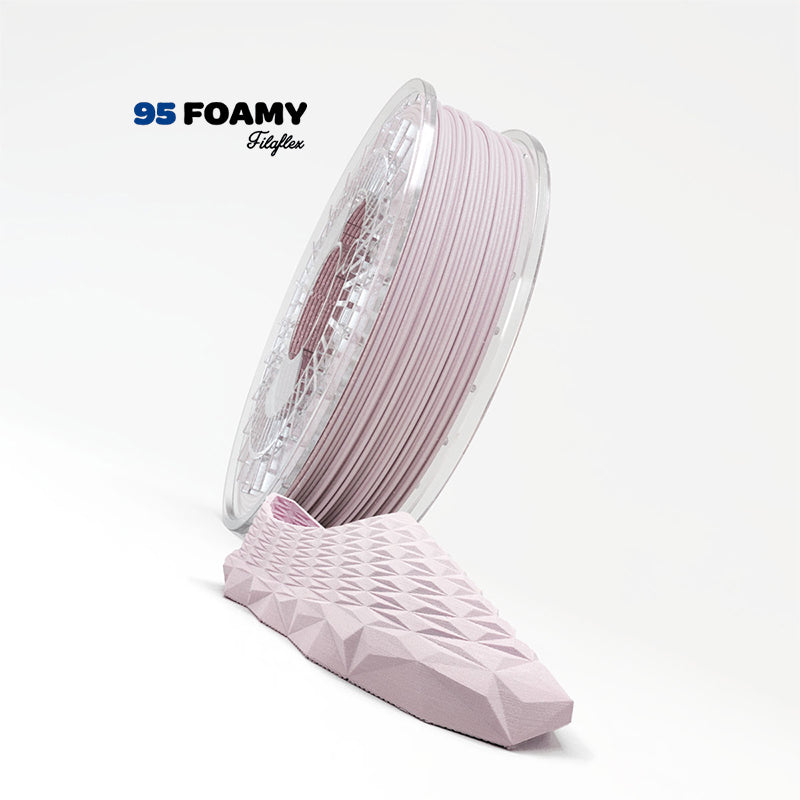
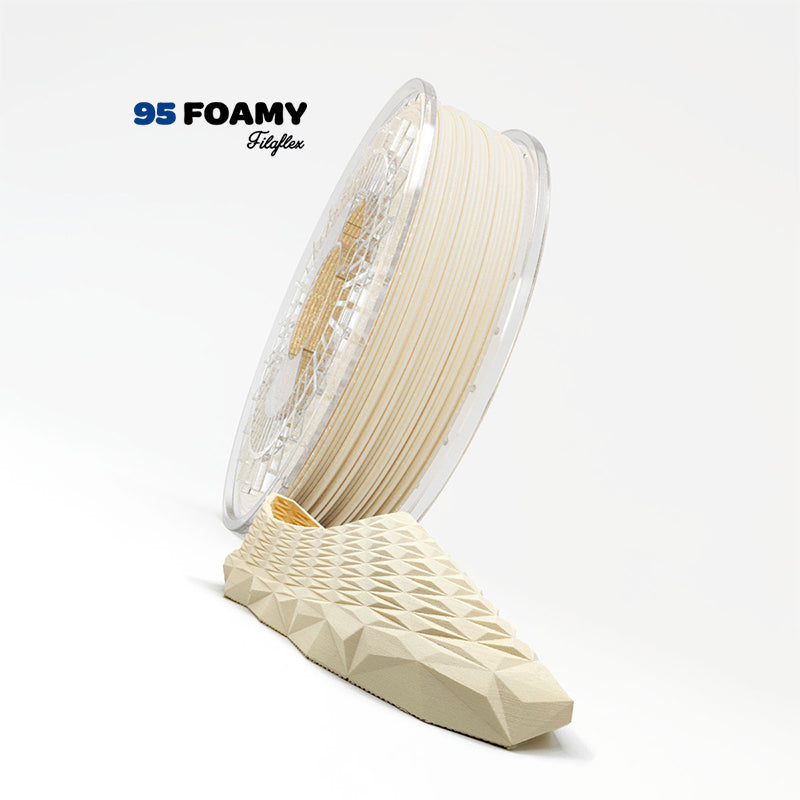
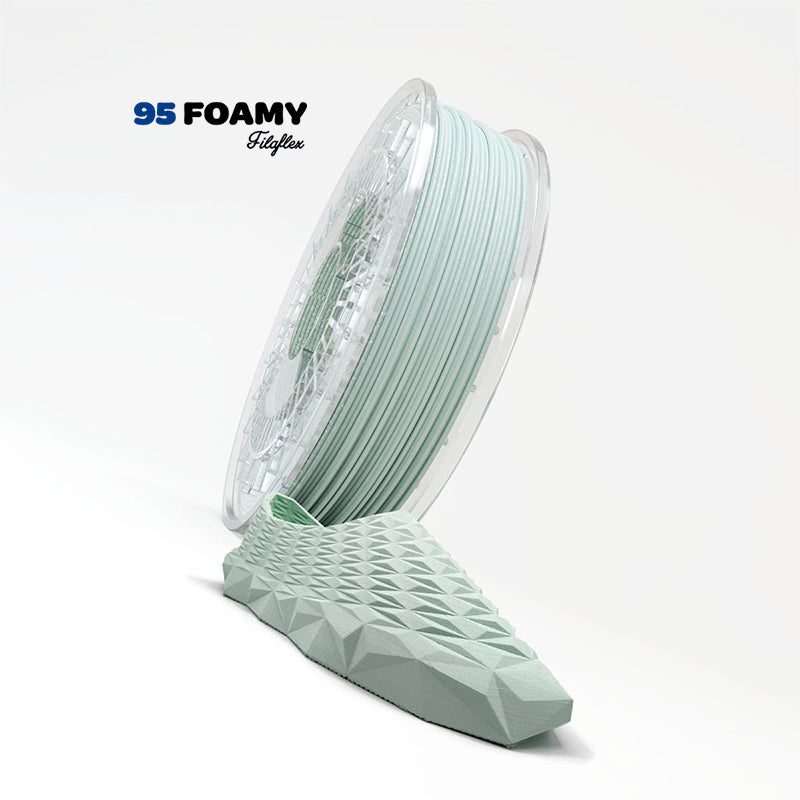
Recreus
Recreus Filaflex 95 Foamy Footwearology Edition 1.75mm
Filaflex 95 Foamy is an advanced TPU filament featuring Dynamic Foaming Technology, designed for high-speed printing of lightweight, elastic parts. With an initial Shore hardness of 95A that can be adjusted down to 70A, this innovative filament offers a unique combination of speed, flexibility, and reduced density. Its enhanced fluidity enables 30% faster printing speeds while maintaining excellent material properties and a smooth, matte finish.
The filament's dynamic foaming properties can be fine-tuned through printing parameters: at 245-250°C with 60-70% flow rate, it expands 1.4-1.6 times its original volume, creating lighter, foam-like parts. This efficiency translates to 30-40% more prints per spool. Additionally, the material offers customizable color intensities based on temperature settings, providing versatility in both mechanical properties and aesthetic finish without changing filaments.
KEY FEATURES:
- Enhanced Speed: 30% faster printing capability
- Adjustable Hardness: Variable from 95A to 70A Shore
- Material Efficiency: Up to 40% more prints per spool
- Dynamic Properties: Customizable density and color tone
- Superior Finish: Smooth, matte surface texture
PROFFESSIONAL APPLICATIONS:
- Medical Devices: Custom prosthetics and orthopedic supports.
- Professional Footwear: Lightweight insoles and shoe components.
- Cycling Equipment: Ergonomic grips and saddle components.
- Automotive Parts: Flexible bumpers and impact-resistant elements.
- Protection Systems: Cushioning and sound absorption components.
COMPLETE TECHNICAL PRINTING GUIDE - FILAFLEX 95A FOAMY
1. MATERIAL PREPARATION
- Filament Drying (CRUCIAL):
- Temperature: 55°C
- Minimum time: 1 hour
- Proper drying is essential for optimal printing results
2. UNDERSTANDING PRINT SPEED
- Volumetric vs. Linear Speed.
- Volumetric Speed (mm³/s): Like water through a hose - measures how much plastic flows per second, regardless of nozzle size.
- Linear Speed (mm/s): Like walking speed - how fast the printer head moves across the print area.
- Key Formula: Linear Speed = Volumetric Speed / (Line Width × Layer Height).
The Magic: When you set a volumetric speed limit in your slicer, it automatically calculates and adjusts all linear speeds (perimeters, infill, etc.) based on your current nozzle size and layer height. This ensures consistent material flow regardless of your print settings!
3. BASIC PARAMETERS
Unique Characteristics of Filaflex FOAMY
This material contains a foaming agent that activates during printing, causing the material to expand when heated. At 100% flow, the line width expands approximately 37.5% more than the nozzle diameter. To achieve the desired line width, flow rate must be reduced to compensate for this expansion.
Colour And Foaming Effect: The material becomes lighter in colour as foaming increases. Higher temperatures and lower flow rates will result in more foaming and consequently lighter colouring. This effect is normal and indicates proper activation of the foaming agent.
|
Nozzle |
Layer Height |
Line Width at 100% Flow |
Optimized Flow for 0.4mm Line Width |
Volumetric Speed |
Temperature |
|
0.4mm |
0.2mm |
0.55mm |
75% |
3.5 mm³/s |
248°C |
|
0.6mm |
0.3mm |
0.825mm |
75% |
7.9 mm³/s |
248°C |
|
0.8mm |
0.4mm |
1.1mm |
75% |
14.0 mm³/s |
250°C |
|
1.0mm |
0.5mm |
1.375mm |
75% |
21.9 mm³/s |
252°C |
Advanced Weight Reduction & Foaming Control
Further Weight Optimization:
Flow rate can be reduced to 60% to achieve maximum weight reduction
Lower volumetric speed allows more time for the foaming agent to activate during extrusion
Fine-tuning Guidelines:
The optimal balance between flow rate and volumetric speed depends on:
- Your specific printer's characteristics
- Part geometry and requirements
- Desired level of foaming effect
Start with our recommended settings (75% flow) and gradually adjust:
- Reduce flow rate in 5% increments (down to 60%)
- Decrease volumetric speed by 10-15% to allow more foaming time
- Monitor line width consistency and material colour change
Important Consideration: Lighter material colour indicates increased foaming activation. Aim for consistent colour throughout your print to ensure uniform material properties.
4. SPEED SETTINGS
NOTE: All speeds are calculated considering the expanded line width and optimized flow rate (75%) to ensure proper material behavior.
0.4mm Nozzle (Volumetric Speed: 3.5 mm³/s)
|
Line Type |
Percentage |
Speed |
|
External Perimeter |
50% |
15.91 mm/s |
|
Internal Perimeters |
75% |
23.86 mm/s |
|
Infill |
100% |
31.82 mm/s |
|
Top/Bottom |
60% |
19.09 mm/s |
|
First Layer |
30% |
9.55 mm/s |
0.6mm Nozzle (Volumetric Speed: 7.9 mm³/s)
|
Line Type |
Percentage |
Speed |
|
External Perimeter |
50% |
15.96 mm/s |
|
Internal Perimeters |
75% |
23.94 mm/s |
|
Infill |
100% |
31.92 mm/s |
|
Top/Bottom |
60% |
19.15 mm/s |
|
First Layer |
30% |
9.58 mm/s |
0.8mm Nozzle (Volumetric Speed: 14.0 mm³/s)
|
Line Type |
Percentage |
Speed |
|
External Perimeter |
50% |
15.91 mm/s |
|
Internal Perimeters |
75% |
23.86 mm/s |
|
Infill |
100% |
31.82 mm/s |
|
Top/Bottom |
60% |
19.09 mm/s |
|
First Layer |
30% |
9.55 mm/s |
1.0mm Nozzle (Volumetric Speed: 21.9 mm³/s)
|
Line Type |
Percentage |
Speed |
|
External Perimeter |
50% |
15.93 mm/s |
|
Internal Perimeters |
75% |
23.89 mm/s |
|
Infill |
100% |
31.85 mm/s |
|
Top/Bottom |
60% |
19.11 mm/s |
|
First Layer |
30% |
9.56 mm/s |
5. RETRACTION SETTINGS
IMPORTANT: Due to the foaming nature of this material, stringing will be more pronounced than with standard TPU. Set travel speed to maximum (200-500mm/s) and ensure proper retraction settings to minimize stringing.
|
Nozzle |
Distance |
Speed |
Z-Hop |
|
0.4mm |
2.5-5.0mm |
65mm/s |
0.2mm |
|
0.6mm |
2.5-5.0mm |
65mm/s |
0.2mm |
|
0.8mm |
2.5-5.0mm |
65mm/s |
0.2mm |
|
1.0mm |
2.5-5.0mm |
65mm/s |
0.2mm |
6. BED TEMPERATURE SETTINGS
Bed Temperature:
- Small parts: No heating (room temperature)
- Large parts: 50-55°C
7. COOLING SETTINGS
Cooling Configuration:
- General: 0% (fan off)
- KEEP FAN ALWAYS: OFF
- Force fan speed for overhangs and bridges: OFF
- Layers < 10 seconds: 40% fan
- First layer: Always 0%
8. TROUBLESHOOTING GUIDE
|
Problem |
Solution |
|
Excessive expansion |
|
|
Insufficient foaming |
|
|
Excessive stringing |
|
9. BEST PRACTICES
- Keep filament dry - store properly and dry before use
- Preferably use direct drive extruder
- Print multiple small parts simultaneously for better results
- Use maximum travel speed to minimize stringing
PLEASE NOTE: These printing parameters are initial recommendations based on our experience. They may need adjustment depending on your specific 3D printer, environmental conditions, and the geometry of the part you are printing. Use these settings as a starting point and fine-tune them according to your specific needs.
Together, Layer by Layer!

